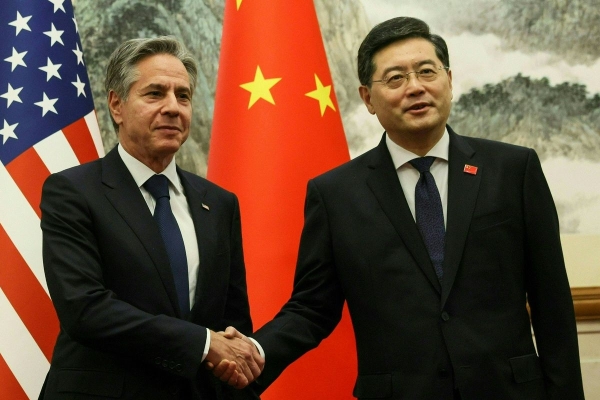US Secretary of State Antony Blinken is meeting with his Chinese counterpart, Foreign Minister Qin Gang — a positive step after years of escalating tension between the two countries and the first time a US secretary of state has visited China in five years.
Blinken’s visit signifies a desire from both parties to keep diplomatic channels open amid an overall trend of deteriorating relations between the two countries, particularly over trade, Taiwan’s independence, and China’s relationship with Russia over the course of its invasion of Ukraine. Blinken was initially set to visit Beijing in February to meet with Chinese President Xi Jinping, but the presence of a suspected Chinese surveillance balloon over the US dashed those plans — and caused even more rancor between the two nations.
Following the discovery of the balloon, which traversed “sensitive sites” over the US, as the Pentagon put it, the US canceled Blinken’s February trip to China and shot down the balloon off the coast of South Carolina. China responded by claiming the object was primarily for civilian use and calling the US’s operation to take down the object an “excessive reaction.”
Over the past few months, relations between the US and China have been particularly strained, and conversations between high-level officials have been rare. That’s been changing on the civilian side, as Blinken’s visit indicates, but tensions over military issues remain high — and conversations between military leadership nonexistent.
In a phone call between Qin and Blinken Wednesday, the Associated Press reported, Qin insisted that the US should “stop interfering in China’s internal affairs, and stop harming China’s sovereignty, security and development interests in the name of competition,” seemingly referring to Taiwan.
The possibility of open conflict between the US and China over Taiwan’s independence has loomed large over the relationship in recent years, particularly as China builds up its military power — specifically its navy. Earlier this month, according to US Indo-Pacific Command, a Chinese guided-missile destroyer cut off a US naval destroyer, which the US deemed an “unsafe” maneuver during a freedom of navigation operation in the Taiwan Strait. That incident is only one of many close calls between US and allied militaries and their Chinese counterparts in the region, raising the specter of conflict due to miscalculation or miscommunication.
Qin and Blinken on Sunday met for more than five-and-a-half hours of discussion, according to the New York Times, though it’s not clear they made any significant progress in addressing either side’s concerns.
Each side has sincere motivations to engage in dialogue
Both the US and China are keen to reestablish high-level relationships; on the US side, there’s concern over the possibility of open conflict in the South China Sea between Chinese and US military forces. China, meanwhile, is eager to press its own “core concerns” and avoid US sanctions on its struggling economy.
“An important reason why China is resuming high-level dialogue with the United States is because it fears that Washington would significantly enhance sanctions and export controls against the struggling Chinese economy if the Biden administration saw no hope for bilateral diplomacy,” Neil Thomas, a fellow for Chinese politics at Asia Society Policy Institute’s Center for China Analysis, told Vox via email. “Beijing has more to lose than Washington from a breakdown in bilateral relations, especially if it leads the Biden administration to lean into economic containment of China. But Xi has to play tough.”
China’s economic recovery has flagged in the months following Xi’s “zero-Covid” strategy. Over the course of the Covid-19 pandemic, the Chinese government imposed strict lockdowns to prevent the spread of the virus, which effectively shut down parts of the economy, too. Though the government abruptly ended the policy in December after a series of protests, the economy has been slow to bounce back, affecting businesses at all levels and across sectors.
Additionally, US export controls prevent companies from selling semiconductor technology to China, which has hampered sectors from defense to artificial intelligence development. Though China is attempting to circumvent that problem by building up its own domestic chip manufacturing industry, Chinese semiconductor technology still lags far behind US technology and faces supply chain, servicing, and scaling issues according to a March report from Reuters.
Ultimately Xi has to balance the appearance of his leadership for his internal audience — looking tough and protecting Chinese interests on the one hand, but not going so far as to completely alienate the US on the other.
“Xi has a personal motivation to ensure that US-China relations do not spiral out of control this year because he wants his visit to the United States for APEC [the Asia-Pacific Economic Cooperation meeting] this November to be a success and show domestic audiences that he is capable of managing China’s thorniest diplomatic relationship,” Thomas said.
On the US side, Blinken reportedly hopes to secure Chinese cooperation in addressing the fentanyl crisis in the US, the Wall Street Journal reported. Law enforcement officials in the US claim Chinese companies are responsible for shipping the raw materials to make the synthetic opioid, which has contributed significantly to the US’s high rate of deadly drug overdoses.
Major aspects of the US-China relationship still need repairing
Despite Blinken and Qin’s success at relaunching talks, the two sides are still at an impasse when it comes to what Chinese state media called the “core of Chinese core interests” — Taiwan. China is adamant that the self-governing nation, which relies heavily on the US for its self-defense capabilities, belongs to mainland China and the two will be united under the leadership of the Chinese Communist Party.
Until 1979, the US recognized Taiwan’s government as the legitimate government of China. Though the State Department closed its embassy in Taipei, the US maintains an unofficial relationship with Taiwan and provides significant military support to the island. The US and its regional defense partners often conduct freedom of navigation operations near Taiwan and in China’s maritime backyard, which China sees as a threat.
“The Chinese leadership will seek to broker a harmonious balance between powers that might well involve Chinese dominance of others, and that sees force and might as possible parts of the tools that can achieve and maintain that balance,” Astrid Nordin, chair of Chinese International Relations at King’s College London’s Lau China Institute told Vox via email. “Like most states that use or threaten to use violent force, the Chinese state will portray any use of force or build-up of military capacity as necessary because of others’ aggression.”
Even more critically, US Defense Secretary Lloyd Austin has thus far been unable to make contact with the Chinese defense ministry, either under former Minster Wei Fenghe, or the current head, Li Shangfu.
Austin reportedly made an attempt to speak to Li at a defense conference in Singapore earlier this month, but Li rebuffed him. “The two leaders shook hands but did not have a substantive exchange,” Pentagon Press Secretary Brig. Gen. Patrick Ryder said in a statement to Politico.
Li has been under US sanctions since 2018 for his role in the Chinese military’s purchase of Russian aircraft and equipment; President Joe Biden declined to lift the sanctions when Li was named defense minister earlier this year.
Over the past several months, the US has also increased military cooperation in the region, including with longtime partners Japan, South Korea, and the Philippines. The US has also made an effort to kindle new relationships in the region, as with a renewed security pact with Papua New Guinea last month.
China sees those relationships as a threat, though many nations in the region still have no interest in cooperating with the US — or at the very least, have as much of a stake in their relationship with China.
Li has said that China’s military is merely responding to provocation from the US and its defense partners. “The best way is for the countries, especially the naval vessels and fighter jets of countries, not to do closing actions around other countries’ territories,” he said at this month’s Singapore defense conference. “What’s the point of going there? In China we always say, ‘Mind your own business.’”
“Chinese leaders have long portrayed the US as the ultimate bad guy bully, against which the Chinese people need to band together, lead by the Chinese communist party,” Nordin said. “At this point in time, we have seen a trend of more aggressive and confrontational rhetoric from Chinese diplomats, which some have argued is a calculated career move after Xi Jinping was seen to reward such rhetoric.”
Despite the outstanding issues between the two countries, the promise of future dialogue sounds a hopeful note. “If there was one word I would use to describe the exchange, it would be ‘direct,’” a senior State Department official told Reuters after Sunday’s meeting. “Both sides expressed a desire to stabilize the relationship and prevent the competition between our two countries from veering into conflict.”






